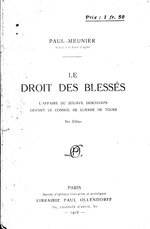Paul Ollendorff
Paul Ollendorff (born February 24, 1851 in Paris , † December 15, 1920 in Choisy-au-Bac ) was a French publisher and bookseller. The publishing house he founded developed its decisive activities in the late 19th century. He also became known through his cooperation with the Leipzig publisher Karl Baedeker from 1883 on the edition of French-language titles of the Baedeker travel guides and the distribution of the entire Baedeker series in France.
Life
He was the second son of the German grammar writer and language teacher Heinrich Gottfried Ollendorff , who had emigrated from Poland at a young age and settled in Paris. Paul and his mother initially lived on the royalties of their father, who died in 1865.
In 1875, the young Ollendorf opened his own bookstore at 28bis rue de Richelieu. Here he comes into contact with Georges Ohnet , who had previously been rejected by the Calmann Lévy publishing house . His Le Maître de forges from 1882 was the first great success of Ollendorff, who is now a promising publisher. Guy de Maupassant soon entrusted him with around ten texts, including Le Horla (1887), or he received his first two novels from Octave Mirbeau for publication. After all, he has Aphonse Allais , Paul Adam , Jean Lorrain , Paul Féval , Abel Hermant , Willy , Jules Renard and Fernand Vanderem under contract. The publisher's catalog contains more than 2000 titles in 1896. Some works impressed with their illustrations, which were strongly influenced by Art Nouveau .
In 1898, at the height of his success, Ollendorff founded the “Société d'Éditions littéraires et artistiques” with other partners to supplement his bookselling business. The business premises were set up at 50 rue de la Chaussée d'Antin . Also Colette and Andre Theuriet let themselves be attracted by this new name. In May 1902 Ollendorff announced the publication of a new series of books for 3.50 francs . His range of popular literature, illustrated and illustrated. a. by Geo Dupuis or José Roy, but could not compete with the more attractive competition. Disappointed and more or less pushed out of the company by the co-shareholders, he used his share proceeds to participate in the magazine Gil Blas , of which he was director from 1903 to 1911. Since 1903 his publishing activities have only run under his own name. He was able to land a real bestseller with the 1905 Prix Goncourt laureate, Claude Farrère . Then he started several inexpensive book series.
When Ollendorff died in 1920, things had grown a little quiet around his publishing house. The Editions Albin Michel took over part of the publishing rights in 1924 ("Ollendorff Fund").
literature
- Notice from Pierre Michel sur Paul Ollendorf . in: Dictionnaire Octave Mirbeau . Published in Mirbeau, Ollendorff et les droits d'auteur ("Mirbeau, Ollendorff and the copyrights"), Cahiers Octave Mirbeau, No. 12 (2005) and 14 (2007).
- Société d'Editions Littéraires & Artistiques / Librairie Paul Ollendorff , Paris 1907, 177 p. (Catalog)
Web links
- Literature by and about Paul Ollendorff in the catalog of the German National Library
Remarks
- ↑ It was published in 1918 by J. Engelhorns Nachf. In Stuttgart under the title Der Hüttenbesitzer .
- ↑ The works appeared under the name Paul Ollendorff, éditeur [publisher] .
- ↑ Compare, for example, the illustrated feuilletons of Librairie Nilsson .
- ^ The Société d'Éditions littéraires et artistiques filed for bankruptcy in January 1940.
Individual evidence
- ^ Jean-Yves Mollier: Dictionnaire encyclopédique du Livre . Cercle de la Librairie 2007, vol. 3, p. 64 f.
| personal data | |
|---|---|
| SURNAME | Ollendorff, Paul |
| BRIEF DESCRIPTION | French publisher and bookseller |
| DATE OF BIRTH | February 24, 1851 |
| PLACE OF BIRTH | Paris |
| DATE OF DEATH | December 15, 1920 |
| Place of death | Choisy-au-Bac |


